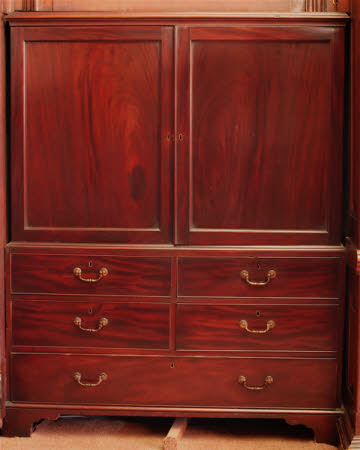Clothes press
Thomas Chippendale (fl. 1766 - 1771 when operating without a business partner)
Category
Furniture
Date
circa 1765 - 1770
Materials
Cabinet - solid mahogany sides, (later?) deal backboards, brass hinges Chest - solid mahogany sides, oak-'lipped' deal dustboards with mahogany-veneered front edge, deal baseboards and (later?) deal backboards, oak drawer stops, red wash
Measurements
160 x 123 x 59 cm
Place of origin
St. Martin's Lane
Order this imageCollection
Erddig, Wrexham
NT 1153320.1
Summary
The carcass of a mahogany clothes press, by Thomas Chippendale (1718-1779), circa 1765-70, set into an alcove in a wall in the Library at Erddig, behind the door into the room. Topped by a moulded mahogany cornice above an upper cabinet with solid mahogany sides, grooved on their inner face to take four sliding trays. The backboards of (later?) deal. The chest of two rows of two graduated short mahogany drawers with a long drawer below. The sides of solid mahogany, the backboards of (later?) deal. The dustboards between the drawers of deal, lipped with oak with a mahogany veneered front edge. The baseboards of deal covered in a red wash. The mahogany bracket feet of laminated construction.
Full description
This clothes press is in the library at Erddig, pushed into a recess (it is not built in) in the paneling and the brick behind it in one of the room's corners. When the door to the Library is open it is totally concealed. It is possible that this was done when Philip Yorke I (1743-1804) converted this room, which is thought to have been the 'Little Parlour' of the 1680s house, into his Library, filling it with books from elsewhere in the house, around 1775. It maybe that this clothes press, like the very good quality library table, were acquired by Philip Yorke I in or around 1770, either as part of the shopping spree he undertook following his marriage to Elizabeth Cust (1750-79) in 1770, or that they came to the Yorke's as part of their inheritance from James Hutton of Newnham, Hertfordshire and Park Street, Mayfair, who died that year. Furniture from both houses is known to have come to Erddig from both houses over the course of several decades: much of it very good quality mahogany furniture of the 1760s. Unlike most pieces of built-in furniture, the only modifications to this piece appear to have been a reduction in height of the moulded cornice, which is unusually shallow. It is also possible that the backboards - which are deal or pine - have also been replaced. These alterations aside, this is a very fine quality press, and is now attributed to Thomas Chippendale (1718-1789) for the following reasons. First, and perhaps most importantly, its closest counterpart is the clothes press [NT 960196] known to have been supplied to Sir Rowland Winn of Nostell Priory by Thomas Chippendale in 1767. The Erddig press is about a third smaller in all dimensions, but both share the same - very unusual - arrangement of two rows of two graduated short drawers above a single long drawer to their chest bases, a feature which is found on other documented pieces of furniture at Nostell Priory by Thomas Chippendale. Three clothes presses made by Chippendale for Nostell Priory have sliding shelves or trays lined with the same marbled paper which lines the sliding trays in this clothes press at Erddig [see NT 959763, the very beautiful clothes press made in 1766/7, and NT 959752, the celebrated green-japanned clothes press supplied for the State Bedroom at Nostell Priory in 1771]. This is a highly unusual feature, not currently known to have been a practice adopted by any other cabinet-maker. The handles on the Erddig press are beautiful quality, and were retailed by Chippendale as 'best pattern'. They are, in fact, more elaborate than those fitted on the drawers of Sir Rowland Winn's press cupboard, but match exactly the handles on the 'secretary' made for Sabine, Lady Winn (1734-98), supplied by Chippendale in 1766. Other features which suggest that the Erddig clothes press was the product of Chippendale's St. Martin's Lane workshop are its laminated bracket feet, chamfered oak drawer stops and the red wash applied to the carcass' deal elements, even to the underside of the baseboards, never intended to be seen. This press and the means by which it came into Yorke ownership are the subject of current research. (Megan Wheeler, February 2019)
Provenance
Photographed in situ in the Library in the early 20th century. Given by Philip Yorke III (1905-1978) along with the estate, house and contents to the National Trust in 1973.
Marks and inscriptions
Dustboard: 2
Makers and roles
Thomas Chippendale (fl. 1766 - 1771 when operating without a business partner), cabinetmaker
